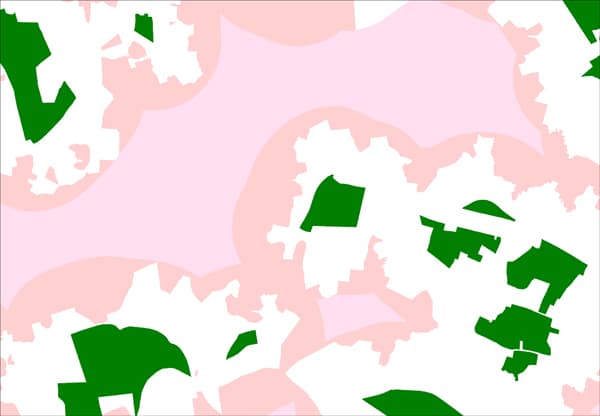Julie MacDonald, GiGL Data Officer

The green shows areas of open space. The light pink, smooth edged areas are the old ‘as the crow flies’ areas of deficiency, created by setting a buffer from the relevant sites. The darker pink with jagged edges are the more accurate data that Julie is currently working on. (You may have noticed a reduction in electricity and a slowing of the internet at night-time as a result.)
Have you ever wondered how many recreation grounds there are in Richmond? Or, what golf courses in Greenwich are called? Or, what area is covered by nature reserves in Newham? Wonder no more. GiGL are coming ever closer to being able to accurately answer all your open space questions. And it’s not only the simple questions we can answer.
This time last year we told you all about our open space dataset and how we were bringing it up to date. We have made significant and measurable progress over the past 12 months, both on the main dataset itself, and on services that make use of it.
We are currently updating GLA survey information on open spaces with more recent information from the boroughs from 2008 onwards. We have now completed this task for two thirds of the boroughs – a significant improvement to the quality and quantity of data available. Data are now available in a consistent format for the whole of Greater London. Open space typologies have been standardised, using both PPG17 categories and sub-categories, along with information on access and ownership types.
The information on site designations has also been updated and improved. Where sites are designated as sites of importance for nature conservation (SINCs), the code that identifies a SINC is given along with the percentage of the open space site which is covered by that designation. Information on other nature designations (SSSIs, SPAs, SACs, Ramsar sites, NNRs and LNRs) is also provided. London borough partners also receive information about the percentage of the site that falls within metropolitan open land and green belt.
Other designations indicated in the open space dataset are London commons, village greens and squares, sites on the English Heritage Parks and Gardens Register and Green Flag winners from 2010 and 2011.
A major part of GiGL’s open space work over the past year has been to create a dataset of spaces designated as public open space (POS). Spaces are divided into a site hierarchy (Regional, Metropolitan, District, Local, Small and Pocket Parks) that provides a benchmark for the provision of public open space across the capital, categorising spaces according to their size, facilities and local importance.
GiGL has sourced the POS designations from published borough documents, and by liaising with some borough officers. In cases where the designations are unclear, or where information is not available, GiGL has surmised likely designations from other information in the open space dataset.
The London Plan sets out a desirable maximum distance which Londoners should travel in order to access each hierarchy level of public open space. Areas outside of these distances are classified as areas of deficiency. By mapping these areas of deficiency, the provision of POS across Greater London can be analysed and open spaces planned and managed accordingly by relevant partners.
Previously, areas of deficiency have been based on distance as the crow flies, which gave no indication of the true distance people would have to travel to access an open space. GiGL has developed a new method of accurately mapping areas of deficiency based on actual walking distances along roads and paths. This involves locating access points and using a clever piece of “network analysis” software to calculate walking routes based on the Ordnance Survey’s information on roads and paths.
GiGL’s open space and areas of deficiency datasets attracted the London Borough of Ealing to become a GiGL partner this year. We were pleased to trial this new method with Ealing, working closely with borough officers to produce accurate maps of areas of deficiency to public open space, which have been published in the borough’s green space strategy. These will be used to analyse open space provision in the borough. Ealing Planning Policy officer Ian Weake says of our work:
“Prior to joining GiGL, Ealing had been grappling with the task of preparing deficiency mapping of public open space in the borough, with limited success. The in-house mapping process had been particularly time consuming and the maps produced had been crude and limited. We were very keen to trail GiGL’s new methodology. GiGL were able to tailor the outputs for our particular needs, and we were able to take advantage of their data sources, particularly in relation to open space adjoining but outside of the borough boundary. The new maps give us a very clear and accurate understanding of deficiency in the borough which has been key to informing the development of policies and proposals in our green space strategy and emerging Local Development Framework documents. We hope to be able to take advantage of GiGL’s new methodology to map deficiency in relation to other types of open space too.”
The model also includes areas from sites outside borough boundaries, giving a more accurate idea of where areas of deficiency lie than using data from only within the borough.
GiGL’s work on AoD mapping is ongoing, but we plan to send the new AoD to POS datasets to GiGL partners in their data exchanges soon. If you would like any further information on POS or AoD, or if there is a project you would like our help on, please contact julie@gigl.org.uk.
